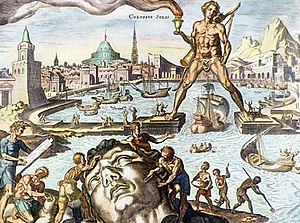The Rhodes Colossusis aneditorial cartoonillustrated by English cartoonistEdward Linley Sambourneand published byPunchmagazine in 1892. The cartoon depicts British business magnateCecil Rhodesas a giant straddling overAfricaholding atelegraph linegrounded at the northern and southern ends of the continent, a reference to his desire to build a "Cape to Cairo"rail and telegraph line connecting most of theBritish colonies in Africa.[1]It is avisual punof theColossus of Rhodes,one of theSeven Wonders of the Ancient World.
| The Rhodes Colossus | |
|---|---|
 Cecil Rhodesstriding from Cairo to Cape Town | |
| Artist | Edward Linley Sambourne,Punch |
| Year | 1892 |
| Subject | Cecil Rhodes |

History
editThe Rhodes Colossuswas drawn by English cartoonistEdward Linley Sambourne,and first appeared inPunchmagazine in 1892. It was widely reprinted,[2]and has since become a standard illustration in history texts.[3]
The cartoon was published in the 10 December 1892 edition ofPunch,accompanied by a recent excerpt fromThe Timesabout a Rhodes plan to extend anelectrical telegraphline fromCape TowntoCairo.The excerpt fromThe Timesreads:
Mr. Rhodes announced that it was his intention, either with the help of his friends or by himself, to continue the telegraph northwards, across theZambesi,throughNyassaland,and alongLake Tanganyikato Uganda. Nor is this all.... This colossalMonte Cristomeans to cross the Soudan... and to complete the overland telegraph line from Cape Town to Cairo; that is, from England to the whole of her possessions or colonies, or 'spheres of influence' in Africa.[4]
The cartoon and excerpt were followed by a piece of satirical verse byEdwin J. Milliken,on the character and ambitions of Rhodes.[3]Satirical verses and stories often accompanied cartoons inPunchmagazine.[5]In the verse, Rhodes is described as a "Director and Statesman in one" and a "Seven-League-Booted Colossus" that stands "O'er Africa striding from dark end to end, to forward black emancipation." He is also described as a "shrewd trader" and a "diplomat full of finesse and sharp schemes with a touch of the piousCrusader".[5]
The Rhodes as Colossus pun used in this artwork was a well-known joke that originated in South Africa and thatPunchhad used before, as well as many others.[3]
Iconography
editSambourne illustrated thisvisual punto depict Cecil Rhodes as theancient Greekstatue theColossus of Rhodes,one of theSeven Wonders of the Ancient World,following the traditional (and architecturally unlikely) depiction of the Colossus with wide-set legs across Rhodes harbour (above).
Rhodes measures with the telegraphic line the distance from Cape Town (at his right foot) in South Africa to Cairo (at his left foot) in Egypt, illustrating his broader "Cape to Cairo" concept for further colonial expansion in Africa. In his right hand Rhodes holds apith helmetwith arifleslung around his right shoulder.
Rhodes stands in a powerful, open armed stance. This has been seen by scholars an indication of his power and influence during theEuropean colonisation of Africa.His giant size indicates his larger than life aspirations and desire for further influence in the continent.
Influence
editThe cartoon quickly became widely referenced in historical texts as an illustrated representation of theScramble for Africa,and theNew Imperialismera as a whole. The original context of a proposed telegraph line is rarely mentioned in such reproductions, which take the "Cape to Cairo" concept more generally.[3]
InAdam Hochschild'sKing Leopold's Ghost: A Story of Greed, Terror, and Heroism, in Colonial Africa,Rhodes is introduced as the "future South African politician anddiamond magnate"who claimed he" would annex the planets "if he could.[6]The South African cartoonistJonathan Shapiroparodied the cartoon in a 2009 work by placingChinese premierWen Jiabaoin place of Rhodes holding upNkosazana Dlamini-Zuma,the-thenMinister of International Relations and Cooperation(as amarionette) while theDalai Lamalooks on from Asia.[7]The cartoon satirizedSino-African relationsin general, and recentChina–South Africa relationsin particular, after the Dalai Lama was denied a visa to attend an international peace conference inJohannesburg,a move that was perceived to be the result of Chinese diplomatic pressure.[8][9]
In 2013, political cartoonistMartin Rowsonreferenced Sambourne's cartoon in asatiricalillustration published on 1 February inThe GuardianonBritish Prime MinisterDavid Cameron's policies regardingAlgeriaand theFrench interventioninMali.[10]
Legacy
editThe cartoon has become one of the most frequently used images to represent the era of New Imperialism and the European colonisation of Africa. Rhodes' legacy in modern-daySouth Africahas been described by scholar Patrick Bond as "one of the world's most lucrative, and destructive",[11]referencing the numerous fraudulent and misleading treaties he signed with variousAfrican peopleswhich ceded portions of their territory to him.[12]
See also
editReferences
edit- ^Crossette, Barbara (13 November 1983)."AN AFRICAN JOURNEY, FROM THE CAPE TO CAIRO (Published 1983)".The New York Times.ISSN0362-4331.Retrieved21 November2020.
- ^Empires, Exceptions, and Anglo-Saxons: Race and Rule between the British and United States Empires, 1880–1910
- ^abcdRichard Scully, 'Constructing the Colossus: the Origins of Linley Sambourne's Greatest Punch Cartoon',International Journal of Comic Art,Volume 14, No.2, Fall 2012, pp.120–142.
- ^"Mr. Rhodes and British South Africa".The Times.30 November 1892.Retrieved22 October2020.
- ^abPunch,Volume 103, 10 December 1892
- ^Hochschild, Adam (1998).King Leopold's Ghost: A Story of Greed, Terror, and Heroism in Colonial Africa.New York, NY:Houghton Mifflin Company.p. 41.ISBN9780618001903.
- ^"The Rhodes Colossus – 118 Years Later".Zapiro.5 April 2009.Retrieved14 June2016.
- ^"Dalai Lama denied visa for South Africa peace conference".CNN.23 March 2009.Retrieved21 April2013.
- ^"Tibetans blame China for Dalai Lama visa denial".Mail & Guardian.South Africa. 23 March 2009.Retrieved21 April2013.
- ^"Cameron's African adventure".The Guardian.1 February 2013.Retrieved1 February2013.
- ^Bond, Patrick (2019)."In South Africa," Rhodes Must Fall "(While Rhodes' Walls Rise)".New Global Studies.13(3):335–350.doi:10.1515/ngs-2019-0036.S2CID210075733.
- ^Getz, Trevor R.; Streets-Salter, Heather (2011).Modern Imperialism and Colonialism: A Global Perspective.Upper Saddle River, NJ: Pearson Education Inc. pp. 229, 238.ISBN978-0-321-42409-9.
Further reading
edit- Punch,10 December 1892,fromProject Gutenberg
- Sven Lindqvist, Joan Tate, and Sarah Death.The Dead Do Not Die.New York: The New Press, 2014.ISBN9781595589897.